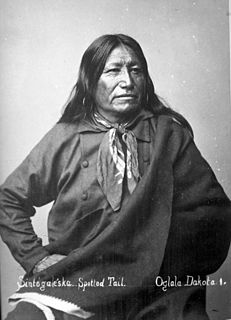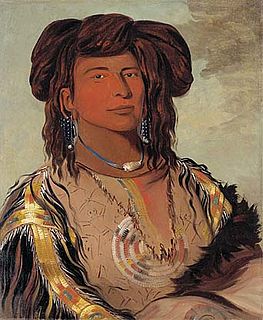Related Research Articles
The Lakota are a Native American people. Also known as the Teton Sioux, they are one of the three prominent subcultures of the Sioux people. Their current lands are in North and South Dakota. They speak Lakȟótiyapi—the Lakota language, the westernmost of three closely related languages that belong to the Siouan language family.

The Sioux or Oceti Sakowin are groups of Native American tribes and First Nations peoples in North America. The modern Sioux consist of two major divisions based on language divisions: the Dakota and Lakota; collectively they are known as the Očhéthi Šakówiŋ. The term "Sioux" is an exonym created from a French transcription of the Ojibwe term "Nadouessioux", and can refer to any ethnic group within the Great Sioux Nation or to any of the nation's many language dialects.

The Wounded Knee Massacre, also known as the Battle of Wounded Knee, was a massacre of nearly three hundred Lakota people by soldiers of the United States Army. It occurred on December 29, 1890, near Wounded Knee Creek on the Lakota Pine Ridge Indian Reservation in the U.S. state of South Dakota, following a botched attempt to disarm the Lakota camp. The previous day, a detachment of the U.S. 7th Cavalry Regiment commanded by Major Samuel M. Whitside approached Spotted Elk's band of Miniconjou Lakota and 38 Hunkpapa Lakota near Porcupine Butte and escorted them 5 miles (8.0 km) westward to Wounded Knee Creek, where they made camp. The remainder of the 7th Cavalry Regiment, led by Colonel James W. Forsyth, arrived and surrounded the encampment. The regiment was supported by a battery of four Hotchkiss mountain guns.

Red Cloud was one of the most important leaders of the Oglala Lakota from 1868 to 1909. He was one of the most capable Native American opponents whom the United States Army faced in the western territories. He defeated the United States during Red Cloud's War, which was a fight over control of the Powder River Country in northeastern Wyoming and southern Montana. The largest action of the war was the Fetterman Fight, with 81 US soldiers killed; it was the worst military defeat suffered by the US Army on the Great Plains until the Battle of the Little Bighorn 10 years later.

The Pine Ridge Indian Reservation, also called Pine Ridge Agency, is an Oglala Lakota Indian reservation located virtually entirely in the U.S. state of South Dakota. Originally included within the territory of the Great Sioux Reservation, Pine Ridge was created by the Act of March 2, 1889, 25 Stat. 888. in the southwest corner of South Dakota on the Nebraska border. Today it consists of 3,468.85 sq mi (8,984 km2) of land area and is one of the largest reservations in the United States.

Bury My Heart at Wounded Knee: An Indian History of the American West is a 1970 non-fiction book by American writer Dee Brown that covers the history of Native Americans in the American West in the late nineteenth century. The book expresses details of the history of American expansionism from a point of view that is critical of its effects on the Native Americans. Brown describes Native Americans' displacement through forced relocations and years of warfare waged by the United States federal government. The government's dealings are portrayed as a continuing effort to destroy the culture, religion, and way of life of Native American peoples. Helen Hunt Jackson's 1881 book A Century of Dishonor is often considered a nineteenth-century precursor to Dee Brown's book.

Crazy Horse was a Lakota war leader of the Oglala band in the 19th century. He took up arms against the United States federal government to fight against encroachment by white American settlers on Native American territory and to preserve the traditional way of life of the Lakota people. His participation in several famous battles of the Black Hills War on the northern Great Plains, among them the Fetterman Fight in 1866, in which he acted as a decoy, and the Battle of the Little Bighorn in 1876, in which he led a war party to victory, earned him great respect from both his enemies and his own people.

American Horse was an Oglala Lakota chief, statesman, educator and historian. American Horse is notable in American history as a U.S. Army Indian Scout and a progressive Oglala Lakota leader who promoted friendly associations with whites and education for his people. American Horse opposed Crazy Horse during the Great Sioux War of 1876-1877 and the Ghost Dance Movement of 1890, and was a Lakota delegate to Washington. American Horse was one of the first Wild Westers with Buffalo Bill's Wild West and a supporter of the Carlisle Indian Industrial School. His record as a councilor of his people and his policy in the new situation that confronted them was manly and consistent and he was known for his eloquence.

Spotted Tail ; born c. 1823 – died August 5, 1881) was a Brulé Lakota tribal chief. Although a great warrior in his youth, and having taken part in the Grattan massacre, he declined to participate in Red Cloud's War. He had become convinced of the futility of opposing the white incursions into his homeland; he became a statesman, speaking for peace and defending the rights of his tribe.

The Miniconjou are a Native American people constituting a subdivision of the Lakota people, who formerly inhabited an area in western present-day South Dakota from the Black Hills in to the Platte River. The contemporary population lives mostly in west-central South Dakota. Perhaps the most famous Miniconjou chief was Touch the Clouds.

Young-Man-Afraid-of-His-Horses [Tȟašúŋke Kȟokípȟapi], also translated as His-Horses-Are-Afraid and They-Fear-Even-His-Horses, was a chief of the Oglala Sioux. Commonly misinterpreted, his name means They fear his horse or His horse is feared, meaning that the bearer of the name was so feared in battle that even the sight of his horse would inspire fear. He is known for his participation in Red Cloud's War, as a negotiator for the Sioux Nation after the Wounded Knee Massacre, and for serving on delegations to Washington, D.C.

Lone Horn, also called One Horn (1790 –1877), born in present-day South Dakota, was chief of the Wakpokinyan band of the Minneconjou Lakota.

The Oglala are one of the seven subtribes of the Lakota people who, along with the Dakota, make up the Očhéthi Šakówiŋ. A majority of the Oglala live on the Pine Ridge Indian Reservation in South Dakota, the eighth-largest Native American reservation in the United States.

A Ballad of the West is a three-part story by Bobby Bridger told in Homeric verse and song about the Mountain Men, William F. "Buffalo Bill" Cody, and the Lakota Sioux people inspired by John G. Neihardt's A Cycle of the West.

Spotted Elk, was a chief of the Miniconjou, Lakota Sioux. He was a son of Miniconjou chief Lone Horn and became a chief upon his father's death. He was a highly renowned chief with skills in war and negotiations. A United States Army soldier, at Fort Bennett, coined the nickname Big Foot – not to be confused with Oglala Big Foot.

The Massacre Canyon battle took place in Nebraska on August 5, 1873 near the Republican River. It was one of the last hostilities between the Pawnee and the Sioux and the last battle/massacre between Great Plains Indians in North America. The massacre occurred when a large Oglala/Brulé Sioux war party of over 1,500 warriors led by Two Strike, Little Wound, and Spotted Tail attacked a band of Pawnee during their summer buffalo hunt. In the ensuing rout more than 150 Pawnees were killed, men with mostly women and children, the victims suffering mutilation and some set on fire.

Little Wound was an Oglala Lakota chief. Following the death of his brother Bull Bear II in 1865 he became leader of the Kuinyan branch of the Kiyuksa band.

Dewey Beard or Wasú Máza was a Minneconjou Lakota who fought in the Battle of Little Bighorn as a teenager. After George Armstrong Custer's defeat, Wasu Maza followed Sitting Bull into exile in Canada and then back to South Dakota where he lived on the Cheyenne River Indian Reservation.

The Wágluȟe Band is one of the seven bands of the Oglala Lakota. The Wágluȟe Band is also known as the Loafer Band.
Joseph Horn Cloud born 1873 and died September 18, 1920. His father was Horn Cloud and mother Nest, both parents died at the Wounded Knee Massacre along with two brothers William Horn Cloud (1876-1890), Sherman Horn Cloud (1865-1890) and a niece. Joseph was a survivor of the massacre as well as his brother Daniel and half brother Dewey Beard[p. 89-95]. Dewey's mother was Yellow Leaf who also died during the massacre. In the early 1900s a writer named Eli S. Ricker began research for a book he was going to call "The Final Conflict between the Red Men and the Palefaces." He gathered sources and interviews about conditions and battles on the Plains during the last half of the 1800s. He recorded the interviews in small note pads known to historians as the "Ricker Tablets." One such interview was with Joseph telling Ricker what he witnessed at the Wounded Knee Massacre, "When the shooting began the women ran to the ravine. The shooting was in every direction. Soldiers shot into one another.... Many of the Indians in the circle were killed. Many of them mingled with the soldiers behind them, picking up guns from dead soldiers and taking cartridge belts."
References
- ↑ "Drumhop".
- ↑ "William Horn Cloud". Ancestry.com .
- ↑ The Man Called CASH: The Life, Love and Faith of an American Legend (book, chapter 8)
- ↑ "Drumhop".
- ↑ "The Encyclopedia of Native Music: More Than a Century of Recordings from Wax Cylinder to the Internet".
- ↑ The Encyclodedia of Native Music. The University of Arizona Press. April 2005. p. 402. ISBN 9780816524471.
- ↑ Library of Congress https://lccn.loc.gov/2005583653
- ↑ "William Horncloud - Traditional Lakota Songs (CR-6150)". Canyon Records.
- ↑ "Lakota Language Consortium Homepage". Lakota Language Consortium.
- ↑ "Nancy Red Cloud". Ancestry.com .
- ↑ http://www.press.uillinois.edu/books/catalog/79wgp7yy9780252023545.html>[p. 33-34]
- ↑ "Song of Dewey Beard - University of Nebraska Press".
- ↑ "Horn Cloud". Ancestry.com .
- ↑ "Joseph Horn Cloud". Ancestry.com .